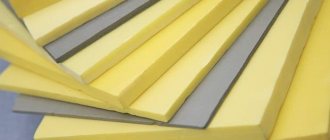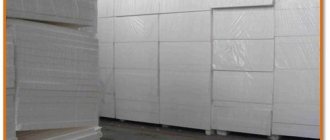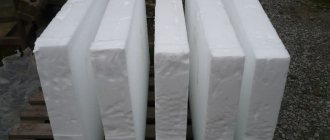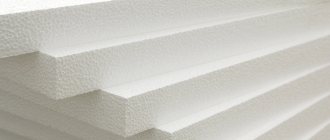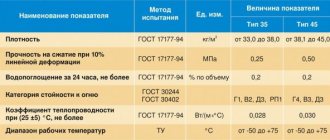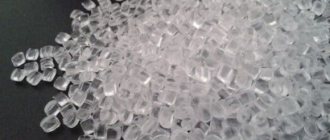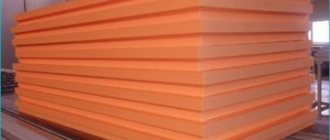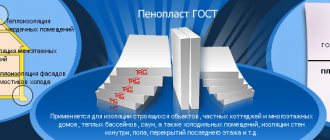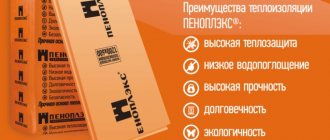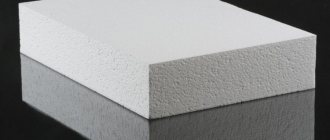Today, there is quite a large demand for extruded polystyrene foam due to the development of both private and commercial construction. Foamed polystyrene has better consumer properties compared to conventional polystyrene, has practically zero moisture absorption, and increased rigidity. Depending on the production technology, foamed polystyrene is of the following types: pressed polystyrene foam EPS - pressless expanded polystyrene PSB XPS - extruded polystyrene foam The price of expanded polystyrene depends on this. Produce extruded foam polystyrene began to be used quite a long time ago; at first, foaming was carried out using hard freons, then a mixture of hard and soft freons was used, then they switched to using only soft freons. After it was proven that freons contribute to the destruction of the ozone layer, foaming with CO2 began to be used instead of freons. For foaming, mixtures of general purpose polystyrene and EPS (expandable polystyrene) are used, pigments or dyes, nucleators, and flame retardants are also added.
The additives used depend on the necessary requirements for the finished product. Foaming occurs using the free foaming method through a flat die, then the resulting web passes through a non-vacuum calibrator consisting of two cooled plates or through cooled forming rolls. When using cooled plates, a thin sheet of fluoroplastic is attached to them to reduce friction between the foaming sheet and the metal of the plates. The calibrator began to be used relatively recently, but previously cooled forming rolls were used.
After pre-cooling and forming, the web passes through a pulling device. After the pulling device, the web is given space for final air cooling, usually this distance is from 10m to 20m, during this distance the web cools almost completely and the foaming process is completed, the product is stabilized and ready for surface treatment. The surface of the canvas is cut, both from the sides and from top to bottom, that is, the canvas is of the correct geometric shape, after which it is cut into sheets of a given length. The cut edges are crushed, granulated and re-processed into the product. With high productivity line, an additional device is used to cool the sheets before packaging. This device is an automatic carousel stacker that takes sheets from one conveyor and transfers them to another conveyor. During the transfer of the sheet, it manages to almost completely cool and stabilize, and accordingly the sheet becomes ready for packaging.
The time the sheet remains on the additional cooling device is from 60 seconds. Next, the sheets are stacked and packed in stretch film or stretch-hood. During extrusion, two single-screw extruders are used, the first is used for melting and mixing the raw materials, and the second as a melt pump, also in the second In the extruder, the foaming additives included in the EPS are completely decomposed. Options for using gear melt pumps are also possible, but they are usually used on low-capacity lines.
Equipment for the production of foam plastic - ready-made production lines or separate installations that can be used to complement the existing configuration. Finished products in the form of expanded polystyrene sheets are used in the construction industry for insulating buildings, creating sound insulation, and finishing external and internal surfaces. This material is supplied in packaging of several sheets up to 100 mm thick each.
Expanded polystyrene production technology
Automated lines and other equipment ensure the preparation of feedstock in the form of granules of a polymer substance, which is loaded into a pre-foamer and treated with water vapor. Foamed granules are sent to a drying unit for up to two days to stabilize the material. To obtain the finished product, molds are used in which high pressure is applied to the polymer to combine the granules into a single structure.
At the final stage, polystyrene foam products are sent to a warehouse, where they are stored for up to one month. During this time, the moisture content of the sheets decreases and internal stresses are relieved. Expanded polystyrene foam cured in this way is cut into sheets of the required sizes and sent to customers.
Approximate configuration of areas for the production of polystyrene foam:
- pre-foamers with steam supply at temperatures above +100 °C; steam generators and steam accumulators (gas, electricity, diesel fuel); fan; secondary blowers to reduce the weight of the finished product; drying chambers; storage bins for expanded polystyrene; cyclic block molds for sintering polymers; installations for vacuuming; cutting apparatus for vertical and horizontal cutting of polystyrene foam using nichrome strings.
The price of installations for the production of expanded polystyrene depends on the configuration, brand of individual elements, productivity, and durability.
Existing configurations can always be expanded with additional components, taking into account the actual operating conditions of the production site (compressors, vacuum accumulators, waste crushers, etc.). The reliability and durability of the installations guarantees a quick payback with a low cost of raw materials and maintenance with a minimum number of personnel.
How polystyrene foam is made
Earlier we told you what polystyrene foam is. We remember that this material consists of numerous cells filled with air. This means that the manufacturing process must include foaming the material.
That’s right: the foaming process is one of the most important in the production of expanded polystyrene .
However, that's not all.
Consider:
Stages of foam manufacturing technology
Typically the process includes:
Now in more detail:
1. Foaming. During this process, the raw materials are placed in a special container (foaming agent), where, under pressure (a steam generator is used), the granules increase approximately 20-50 times. The operation is completed within 5 minutes. When the granules reach the required size, the operator turns off the steam generator and unloads the foam material from the container.
2. Drying the resulting granules. At this stage, the main goal is to remove excess moisture remaining on the granules. This is done using hot air - it is directed from bottom to top. At the same time, for better drying, the granules are shaken. This process also does not last long - about 5 minutes.
3. Stabilization (tracking). The granules are placed in bunkers, where the aging process takes place. The duration of the process is 4...12 hours (depending on the ambient temperature and the size of the granules).
Important note: the polystyrene foam manufacturing technology may exclude the 2nd stage (drying). In this case, stabilization (tracking) will last longer - up to 24 hours.
4. Baking. This stage of foam production is often called molding. The idea is to connect the previously obtained granules together. To do this, they are placed in a special mold, after which the granules are sintered under pressure and under the influence of high temperature water vapor. Lasts approximately 10 minutes.
5. Maturation (aging). The goal is to rid the resulting polystyrene foam sheets of excess moisture, as well as remaining internal stresses. To do this, the sheets are placed in a free space in the production workshop for several days. In some cases, ripening can take up to 30 days.
6. Cutting. The manufactured foam blocks are placed on a special machine, on which the blocks are cut into sheets of appropriate thickness, length, width. This manufacturing process is performed using nichrome strings heated to a specific temperature. Accordingly, both horizontal and vertical cutting of blocks is carried out.
This is how foam is made.
Of course, after the listed 6 stages, the 7th stage can be performed - processing the remaining scraps . As a result, they are mixed with other granules, which will then undergo the same processes - sintering, curing...
The equipment that is used in the production of polystyrene foam is shown in table form:
Advantages of using automated lines:
- the ability to purchase installations of high or low productivity, taking into account the requirements for the quantity of finished products at a particular enterprise; collapsible design of most modules that can be quickly dismantled and replaced; automatic control of production process parameters, a wide selection of settings and adjustments, emergency mode signaling; ease of access to structural components elements to replace faulty elements or upgrade components.
The catalog presents equipment whose manufacturers guarantee trouble-free operation and perform installation and commissioning work.
Equipment for the production of foam concrete or expanded polystyrene is used in the production of rectangular blocks or sheets, which are in demand in the construction of housing, public, industrial and other buildings. The materials are used for the construction of horizontal enclosing structures inside buildings, creating sound and heat insulation. Finished blocks or sheets of expanded polystyrene are delivered to construction sites in batches on pallets (up to 50 pcs.) in plastic packaging and packs of 5–10 sheets.
Which taxation system to choose for a foam production business?
The organizational form of the enterprise is individual entrepreneur or LLC (legal entity). Individual entrepreneurship is easier and cheaper to register than a legal entity. However, large wholesale companies prefer to work more with organizations rather than with individual entrepreneurs. Much also depends on production volumes - for small volumes, an individual entrepreneur is enough, then with an increase in production volumes and sales markets, it is definitely necessary to register an LLC.
A legal entity can create branches and representative offices in other cities, and it is safer from a legal point of view - an LLC is liable for obligations only with property belonging to this organization, while an individual entrepreneur is liable with all property belonging to an individual (apartment, car, etc. .).
Production of foam plastic and foam concrete
For the production of foam concrete, automatic complexes with the following equipment are used:
- vibrating screens, belt conveyors for grinding and feeding raw materials; weighing dispensers, strain gauges, gates, vibrating units with electric or pneumatic drive; mixers with a foam generator and unloading devices; automatic equipment for adjusting dosing and supply of raw materials;
The price of such equipment is determined depending on the set of components, technical characteristics of the finished product and the degree of automation of all technological processes.
Foam (expanded polystyrene) production technology
Home / Technology for the production of foam plastic (expanded polystyrene)
Content:
- Pre-foaming of granules.
- Conditioning of pre-foamed granules.
- Molding of polystyrene foam blocks.
- Conditioning of polystyrene foam blocks.
- Cutting polystyrene foam blocks into slabs.
- Use of polystyrene foam waste.
1. PRE-FOAMING
1.1. Brief characteristics of raw materials
The raw material used is foamed self-extinguishing polystyrene containing 5-6% of a mixture of pentane and isopentane, which is a foaming factor. This mixture is contained in polystyrene granules in dissolved form.
The raw material is in the form of granules obtained by suspension polymerization of styrene. It contains a substance that reduces flammability - a fire retardant.
After heating to a temperature of 90-100°C, under the influence of volatilizing pentane, the granules increase their volume (foaming process) by approximately 30-65 times. In industrial practice, water vapor is used to foam polystyrene, which also penetrates into the granules and promotes the action of pentane.
International designation of foamed polystyrene: EPS self-extinguishing FS.
Storage:
Store exclusively in original, tightly closed containers or containers installed in ventilated areas or under a canopy, far from sources of heat and fire. It is recommended to store raw materials at a temperature not exceeding 20°C.
A product stored at the recommended temperature should be used no later than 3-6 months from the date of product examination indicated in the quality certificate. Product from partially emptied or damaged containers should be used immediately.
In production facilities, raw materials can be stored in quantities not exceeding their average daily consumption.
1.2. Processing of expanded polystyrene.
The final density of the finished product is determined already at the pre-foaming stage.
An important indicator is pressure control during the foaming process, for continuous pre-expanders 0.015-0.03 MPa, for cyclic 0.015-0.02 MPa.
There are two ways to change the imaginary density of a product in a foamer:
- by changing the amount of raw materials supplied;
- by changing the level of foaming material in the working chamber;
The first and second methods affect the residence time of the foaming material in the working chamber. The third method affects the temperature in the chamber.
The effect of the residence time of the raw material in the blowing agent on the imaginary density of the product is presented in Fig. 1.2.
If the time the raw material is in the foamer is too long, the granules begin to shrink and the density increases; If the temperature is too high, the foam granules may form lumps. Both of these phenomena can occur simultaneously. And have a direct impact on the quality of the final product.
Density
Duration of pre-foaming
Fig.1.2. Relationship between imaginary density and foaming duration
In order to obtain low density (< 12 kg/m3), two-stage foaming is used. Two-stage foaming is carried out using the same equipment used for single-stage foaming, feeding the pre-foamed raw material through a secondary foaming system.
In order to achieve optimal foaming results, the granules must be saturated with air (conditioning process) before foaming the second stage.
The pre-foamed granules enter a fluidized bed dryer, where warm air (temp. approximately 30-40°C) passes through the perforated bottom of the dryer, dries and propels the granules towards the discharge fan.
The air stream must be distributed in such a way that the process of drying and moving granules proceeds evenly along the entire length of the dryer (adjustment is carried out using dampers in the air chambers of the dryer).
One of the extremely important factors influencing the foaming of polystyrene is the duration of storage of raw materials. The older the raw material, the longer the foaming and the more difficult it is to achieve the required imaginary density of the foamed granules. Therefore, the shelf life of raw materials in sealed packaging is limited to six months.
1.3. Technical equipment of the pre-foaming unit
a) foamer VP-03
b) secondary foaming system SVV-1
c) continuous granule dryer SS-106
d) unloading fan VPV-2.5
2. CONDITIONING PRE-FOAMED GRANULES
2.1. Basics of the Pellet Conditioning Process
During conditioning, air penetrates into the foam granules due to the vacuum formed in them, and moisture in the form of steam and pentane, unreacted residues of the polymerization process of raw materials, are released into the atmosphere from the foam granules. This gas exchange is possible due to the gas permeability of polystyrene shells.
Fig.2.1. Expandable polystyrene granules during conditioning process
The rate of air diffusion into the granules is determined mainly by the imaginary density, ambient temperature and granule size. The goal of removing moisture from the surface of the granules in a fluidized bed dryer is to obtain a 100% virtual surface through which gas exchange occurs.
The evaporation rate of pentane also depends on density, ambient temperature and granule size. Pentane evaporates from large granules more slowly than from small-diameter granules, which is due to the ratio between the surface of the granule and its mass.
2.2. Technical equipment of the granule conditioning unit
Silos used for conditioning foam granules are manufactured in the form of a lightweight metal rack-type structure with containers made of breathable fabric.
When moving foam granules using a stream of air, strong electrostatic charges accumulate on the surface of the granules. Therefore, it is extremely important to carefully ground all metal elements of silos, transport pipelines and other equipment.
2.3. Granule conditioning parameters
The ambient temperature in the pellet conditioning workshop should not be lower than 15°C; at lower temperatures, the duration of conditioning increases. In summer, at temperatures above 20°C, the conditioning time is reduced, and at lower temperatures it is extended.
When transporting fresh granules to silos, their apparent density increases as a result of collisions with the walls of the pipeline. Therefore, when setting foaming parameters, it is necessary to take into account the increase in density during transportation.
3. FORMING POLYSTYRENE FOAM BLOCKS
3.1. Characteristics of the molding process
When producing blocks, foam granules are freely poured into the mold chamber until it is completely filled.
Then saturated dry water steam is supplied into the mold under a pressure of 0.2-0.4 MPa, which leads to a further increase in the volume of the granules. Due to the fact that the granules are in a closed chamber, the free space between them is first filled, and then the granules adhere to each other. Fig.3.1.1. An example of a phase cycle for forming blocks without using a vacuum
1) filling 2) blowing 3) steaming 4) cooling 5) unmolding
Fig. 3.1.2. Example of a phase cycle for forming blocks using vacuum
| 1) filling 2) vacuum 3) blowing 4) steaming - growth | 5) steaming - holding 6) release 7) vacuum cooling unloading unloading |
An important factor when steaming a block is supplying the appropriate amount of steam into the chamber into the free space between the granules in the shortest possible time. This requires appropriate ventilation (blowing), the purpose of which is to remove air before starting the steaming process. Insufficient duration of blowing leads to non-uniform density and poor sintering of the block.
It is also important to maintain a constant high temperature of the mold, otherwise the steam consumption increases significantly (Fig. 3.1.3) and the steam becomes wet, which reduces the quality of adhesion of the granules.
Fig.3.1.3. Approximate steam consumption depending on mold temperature The pressure that the block exerts on the inner walls of the molding chamber is approximately 0.08 MPa. In order for the block to be removed from the mold without damaging it, this pressure must be reduced to a value of about 0.01 MPa. The time required to reduce the pressure of the block, that is, the cooling time, depends on the brand of foam.
Fig.3.1.4. Approximate cooling time for the unit depending on the duration of conditioning. In the blowing and cooling phase, a vacuum is applied to intensify the steaming process and speed up the cooling process.
3.2. Technical equipment of the molding unit
a) block form UCIP 1030.
b) vacuum installation VU-3.3 with vacuum accumulator AV-1.
c) system for vacuum loading and cooling of blocks.
d) compressor unit SB4/F-500
e) steam accumulator PN-5000
f) steam boiler
4. CONDITIONING BLOCKS
4.1. Brief description of the block conditioning process
After the molding process is completed, the blocks are conditioned. Conditioning is carried out to reduce humidity and eliminate internal stresses that arise during molding. In addition, processes of gas diffusion and equalization of pressure inside the granules with atmospheric pressure occur, similar to the processes that occur during conditioning of pre-foamed granules.
In the process of conditioning blocks, the order of their use, corresponding to the order of molding, plays a very important role, that is, when selecting blocks for cutting, you should start with the “oldest”.
5. CUTTING POLYSTYRENE FOAM BLOCKS INTO PLATES
5.1. Characteristics of the polystyrene foam cutting process
The blocks are cut using a rheostatic wire heated to the appropriate temperature.
All waste is fed into a shredder, from where, in crushed form, it is pneumatically transported for recycling.
5.2. Quality requirements
Appearance
The coloring of expanded polystyrene boards should be the same as the coloring of pre-foamed polystyrene granules.
It is necessary to carry out a spot check of the slabs - at least 2 pcs. along the length of each block.
If the slabs meet the requirements, then after stacking they are sent for packaging.
If the deviation from the required dimensions exceeds the permissible value, then you should once again check one plate along the entire length of the block, determine the reason, and make appropriate adjustments to the gaps between the sections of the rheostatic wire.
Check the dimensions of the slabs obtained by cutting the next block in the same way.
Plates that do not meet the requirements are sent for recycling.
6. USE OF POLYSTYRENE FOAM WASTE
The waste is reused in the production of blocks.
6.1. Technical equipment of the unit
a) polystyrene waste crusher
b) process silo
6.2. Grinding system
The device is designed for grinding polystyrene foam waste, resulting in crumbs used as an additive to polystyrene granules in the production of polystyrene foam blocks. The size of the crumbs obtained in this way is up to 15 mm.
Interesting? Leave a bookmark to come back here later!
Features of foam production technology
When producing foam concrete or expanded polystyrene, the raw materials in the form of sand or polymer substances undergo preliminary preparation and are then fed to the line for forming finished products. To obtain polystyrene foam, polystyrene granules are foamed, which are then dried, steamed, vacuumed and sheets of expanded polystyrene are formed under pressure.
Finished products are packaged using automatic devices and unloaded into storage areas. Expanded polystyrene packaging is lightweight and therefore does not require complex lifting equipment. Heavier foam blocks are placed on pallets, which can be lifted with a forklift or cranes with the appropriate sling set.
Advantages of equipment for foam materials:
- the cost of automated lines quickly pays off due to the reduction in maintenance costs and the involvement of a minimum number of personnel; the installations are compact in size and do not require the allocation of premises or large areas; the modular design ensures the quick replacement of faulty units, the modernization of the existing configuration when performance requirements change; new location, dismantled lines are transported by conventional vehicles.
Companies that offer to buy machine equipment for the production of foam materials provide a guarantee for their products, organize delivery, and perform installation and commissioning work. Specialists from such manufacturers conduct classes with staff, teaching the basics of technological processes, maintenance and repair of installed models. Almost all equipment is designed for long-term and intensive use, which eliminates work stoppages due to sudden breakdowns.
Extruded polystyrene foam is a synthetic thermal insulation material consisting of polystyrene granules mixed at high pressure and temperature with the introduction of a foaming component and subsequent extrusion from the extruder. It is also called extruded polystyrene foam, abbreviated as EPS, or XPS.
Production technology and composition
The chemical composition of the material is similar to polystyrene foam.
Its main component is polystyrene foam granules. They are mixed with fire retardants, which reduce flammability, and substances that increase the strength and improve the characteristics of polystyrene foam, and then melted at elevated temperatures. After obtaining a homogeneous molten mass, a foaming agent, carbon dioxide, is introduced into it under high pressure.
After this, the material goes through an extrusion process. The resulting hot mass is forced through the rectangular hole of the extruder.
As the pressure drops to normal levels, carbon dioxide expands and foams the mass. Using the size of the extruder hole, the thickness and width of the resulting strip are adjusted. The XPS strip is sawn into slabs of specified dimensions.
The use of extruded polystyrene foam complies with the requirements of SNiP 21-01-97 “Fire safety of buildings and structures”. Federal Law No. 123 regulates the toxicity of combustion products.
High-quality EPS has a T2 rating and is classified as a moderately dangerous insulation material. Wood materials, such as parquet, have the same indicator. Production, testing methods, labeling of extruded polystyrene foam are regulated by the requirements of GOST 32310-2012.
Marking
Foamed polystyrene foam is marked according to GOST and European standards.
According to GOST, the marking must contain the following data:
- Product name Name or trademark of the manufacturer and its address Work shift, date of manufacture, workshop of the manufacturer Fire safety class Thermal resistance Thermal conductivity Nominal thickness Marking code Type of cladding or coating, if any Length and width Number of products in the package and their total area, if necessary
European standards for marking XPS are specified in document EN 13164:2001. However, different manufacturers have their own designations for the main characteristics. For example, material under the Penoplex brand has the following markings:
- Type indication – 30, 35, 45 Identification of the corrugated surface Identification of the selected quarter Slab thickness in mm
This marking looks like this: 35GS-30.
Release form
XPS is produced in the form of slabs, substrates and decorative elements.
The slabs have dimensions of 600x1200 and 600x2400 mm. Some manufacturers produce slabs with a width of 600 and 580 mm. Their thickness ranges from 20 to 100 mm.
They are supplied to stores in packages. The number of slabs in a package varies and depends on their thickness. Thus, 50 mm thick EPS is sold in packs of 8 pieces, 100 mm thick - 4 pieces.
In addition to slabs, the material is produced in the form of a base for flooring.
There is a substrate for parquet, laminate and linoleum. Also, various decorative elements that are made from gypsum can be made from expanded polystyrene. At the same time, the appearance of the products is practically no different from plaster.
Extruded polystyrene foam: characteristics
Strength within 2-3.6 kgf/sq.
cm at 10% linear deformation and 4-7.1 kgf/sq. cm for static bending. The strength indicator of EPPS directly depends on its thickness and density. Volumetric weight is 15-29 kg/cubic.
m and 30-36 kg/cu.m. m. The first is used for insulating houses and industrial buildings and is attached to unloaded structures - walls, ceilings, interfloor ceilings.
The second is used for insulating foundations, floors, roofs and other horizontal and inclined surfaces. There is virtually no shrinkage of the material under any operating conditions. Thermal conductivity is 0.026 W/mC at an average temperature of 10 C. As an insulation material, polystyrene foam is noticeably superior to other materials. For example, 50 mm thick foam insulation will be equivalent to 20-30 mm EPS. Frost resistance.
The material loses only 5% of its thermal resistance after 1000 freeze-thaw cycles. The temperature range in which it does not change the physical and thermal conductivity parameters is from -50 to +75 C. Water absorption is not higher than 0.5% of the volume for 30 days. Low moisture absorption is due to the low capillarity of the material.
This allows it to be used in conditions of high humidity and for insulating basement floors, foundations and roofs. Water absorption occurs only on the surface due to the fact that there are destroyed cells there. Vapor permeability depends on the thickness and density of the EPS. Plates with a thickness of 20 mm have a vapor permeability equivalent to one layer of roofing felt.
Expanded polystyrene of the Penoplex brand has a vapor permeability coefficient of 0.007-0.012 mg/(mchPa). The fire resistance class of conventional EPS is G3-G4. The addition of fire retardants raises the class to G1. The material is not completely non-flammable, but has sufficient fire resistance for use in the construction of buildings and structures. The cost of the material is calculated per square meter or cubic meter.
Depending on the manufacturer and brand, it ranges from 55-80 rubles/sq. m. or from 3800 rub./cub.
m. Sound insulation. Impact noise reduction index – 25 dB. XPS refers to materials used for insulation against impact noise. Environmental friendliness.
The insulation is classified as moderately hazardous and has a toxicity class of T2. It is not subject to decomposition in the environment, the appearance of fungi and mold. The service life of extruded polystyrene foam is comparable to the service life of the building. High-quality material lasts more than 40 years, subject to compliance with installation technology.
Foam production technology
The technological process for the production of insulating polystyrene foam boards (foam) consists of the following stages:
1.1 Characteristics of raw materials.
Expandable polystyrene is used as the starting material, which is a product of suspension polymerization of styrene in the presence of a blowing agent (5-6% mixture of pentane and isopentane), as well as in a small amount (for use in construction) of a fire retardant based on bromine compounds (less than 1%). ) Expandable suspension polystyrene is produced in the form of spherical particles, the surface of which is treated with various substances that prevent the accumulation of electrostatic charges during transportation and improve the processability of the polymer during processing. Types and brands of foaming polystyrene may be different for each manufacturer, so you need to look at examples of symbols in the technical documentation. International designation of expandable polystyrene: EPS (Expandable PolyStyrene) - expandable polystyrene, FS - self-extinguishing polystyrene, domestic analogs - PSB (Suspension Pressless Expanded Polystyrene), PSB-S (Suspension Pressless Expanded Polystyrene).
1.2 Storage of raw materials.
Expandable polystyrene is stored in dry and ventilated areas, on shelves or pallets spaced at least 5 cm from the floor at a temperature not exceeding 25 °C:
— when packed in cardboard drums and containers with a polyethylene liner — 3.5 months;
— when packed in soft containers and paper bags with a plastic bag liner — 3 months.
The packaged material should not be exposed to direct sunlight or heating devices.
2. Technological diagram.
The production flow chart includes the following stages: preliminary foaming of granules, curing of foamed granules, final foaming and sintering into a monolithic foam mass. Saturated water vapor is used as a coolant in the first and third stages.
2.1. Pre-foaming of raw materials.
This is one of the most important stages in foam production technology, which has a great impact on the quality of the final product. The required amount of raw material is loaded into the pre-expander, after which steam is supplied under pressure. As a result, the granules of the raw material increase many times in diameter (“foam”). When the foamed granules reach a volume of 1 m3, the steam supply process stops, the pre-foamer is unloaded and the foamed granules are transported by pneumatic transport to the holding bunker.
For the production of various grades of expanded polystyrene by density, the following are of great importance: - grades of foaming polystyrene, because polystyrene granules of different sizes (fractions); — quantity of supplied granulate; — parameters of steam supplied to the pre-foamer; — final volume of foamed granules. The residence time of the material in the pre-foamer also affects the density: - the time is too long - the pre-foamed balls begin to collapse (crack) and the density increases; - the time is too short (at high densities), then there may be a significant spread in density and it will be necessary to reduce the temperature by introducing a small amount of air and reduce the intensity of the pre-foamer feed. The ratio of the residence time of the material in the pre-foamer to the density is shown in Fig. 1
For the production of light grades of foam plastic (8-9 kg/cub.m.), double foaming is used. The re-loaded granules must be well saturated with air; as a rule, the curing time before the second foaming should be sufficient; the smaller the granules, the shorter this stage should be.
2.2. Drying and aging of foamed granules in ripening bunkers.
The pre-foamed granules are slightly dried and cooled in a dryer, into which warm air at a temperature of 30-35°C is supplied through a perforated panel. Freshly pre-foamed granules are under slight vacuum and are very sensitive to changes in the external environment, so they are “blown” by a fan into storage hoppers, where the internal stresses of the granules are stabilized. Depending on the raw materials used, the holding time is 12 - 24 hours. The ambient temperature for conditioning granules should not be lower than 16ºC; at lower temperatures, the conditioning duration increases, and in summer, at temperatures above 20ºC, the conditioning time is reduced. When transporting fresh granules to silos, their apparent density increases as a result of collisions with the walls of the pipeline. Therefore, when setting foaming parameters, it is necessary to take into account the increase in density during transportation. At the aging stage, due to the fact that the pressure inside the granule is below atmospheric pressure, air begins to enter the granule; water and pentane are “squeezed out” from the granule until the granule stabilizes. This stage is very important for subsequent high-quality molding.
The rate of air diffusion into a granule depends on the density, temperature and size of the granule. This also applies to the rate of pentane emission, because Pentane evaporates from large granules more slowly than from small granules due to the lower surface area to mass ratio. For good molding, a pentane content of 1.8-2.4% is required for densities of 40 kg/m3 and higher; if a density below 40 kg/m3 is required, the pentane content should be 2.7-3.2%. Thus, the lower the required density, the shorter the curing (conditioning) time of the pre-foamed granules.
2.3. Molding a block of polystyrene foam into a block form.
After aging, the granules are loaded into a block mold by pneumatic transport. Next, they are heat treated, as a result of which the granules re-expand, thus forming a foam block inside the installation. Then the process of cooling the molded block occurs by creating a vacuum vacuum in the working chamber of the block mold. Pushing out the finished block from the block mold is performed either by a pusher powered by a pneumatic cylinder, or by a “pneumatic cushion”, depending on the chosen design of the block mold.
Fig.3.1. An example of a phase cycle for forming blocks without using a vacuum
Fig.3.2. Example of a phase cycle for forming blocks using vacuum
The most important factor when introducing steam into a block mold is that you need to provide a large volume of steam in the shortest amount of time. To do this, it is necessary to remove air from the block mold before the pressure is built up. This is easy to do using a block mold vacuum device. It is also important to maintain a constant high temperature of the mold, otherwise the steam consumption will increase significantly and the steam will become saturated, which reduces the quality of adhesion of the granules (bindability).
Fig.4. Approximate steam consumption depending on mold temperature
The pressure that the block exerts on the inner walls of the molding chamber is approximately 0.08 MPa. In order for the block to be removed from the mold without damaging it, this pressure must be reduced to a value of about 0.01 MPa. The time required to reduce the pressure of the block, that is, the cooling time, depends on the brand of foam.
Fig.5. Approximate unit cooling time depending on conditioning duration
During the blowing and cooling phase, a vacuum is applied to intensify the steaming process and speed up the cooling process. Our company supplies block molds with different production methods: open and closed type. Using an open block mold, your workshop can produce blocks and slabs of unlimited length, but a closed block mold has greater productivity.
2.4. Block exposure.
After the molding process is completed, the blocks are conditioned. Conditioning is carried out to reduce humidity and eliminate internal stresses that arise during molding. In addition, processes of gas diffusion and equalization of pressure inside the granules with atmospheric pressure occur, similar to the processes that occur during conditioning of pre-foamed granules. Molded blocks are kept for 12 - 24 hours under normal conditions before cutting.
2.5. Cutting blocks into sheets.
Cutting blocks in order to obtain sheets of foam plastic of the required sizes is carried out on horizontal or vertical cutting using rheostatic wire heated to the appropriate temperature.
2.6. Waste crushing.
Production waste is crushed in a crushing plant, from which it is loaded via pneumatic transport into a separate storage hopper. Crushed polystyrene foam (the resulting crumb size is up to 15 mm) is reused in the production of polystyrene foam boards by adding it to newly foamed granules in a ratio of about 1:10.
Advantages and disadvantages
Advantages of extruded polystyrene foam over analogues:
- Very low moisture absorption Durability Easy to use and install High thermal insulation ability Strength and ability not to lose shape and volume under different operating conditions
Along with its advantages, it has some disadvantages.
Among these is a low level of vapor permeability. As insulation, it is not suitable for all types of premises. If you insulate a residential building with it, it will turn into a thermos that cannot breathe.
Another disadvantage is the cost, which is higher than other insulation materials. Although the technical characteristics and price of extruded polystyrene foam are adequate to each other. Finally, the sound absorption of XPS in practice is quite low.
Facade insulation with polystyrene
Foaming polystyrene can be mounted on the façade in several ways. Thus, there is a traditional way of insulating building facades by gluing polystyrene boards on them, followed by putty passed through special fiberglass.
In addition to this method, experts resort to using a type of material such as impact-resistant polystyrene. This type of polystyrene boards is characterized by increased resistance to mechanical damage. In addition, such slabs are simply mounted on the facade wall, and the process of priming and putty can be carried out before their installation. It should be noted that façade polystyrene boards are subsequently finished in the form of cladding or painting.
Before starting work on finishing the façade of a house, most developers confidently say “I’ll buy polystyrene,” but they often have a problem: where can I buy foam polystyrene? In fact, such questions should not arise today, since this material is in great demand, and specialized construction supermarkets sell it. One of the leading manufacturers offers products under the Penoplex brand.
Along with the common foamed polystyrene, extruded polystyrene is also relevant, obtained by mixing material granules at high temperatures, followed by separation from the extruder and the addition of a foaming element. Due to its extraordinary structure, this type of polystyrene is characterized by stable thermal insulation and thermal conductivity characteristics. As a rule, it is used in combination with plaster, concrete and other cement mixtures.
Sales of polystyrene
Polystyrene is sold in granules - it is an environmentally friendly material with a high degree of thermal insulation and sound insulation. In construction it is used as insulation for: interfloor ceilings; impact-resistant floors; floors for industrial purposes, intended for moving vehicles; roofs with a maximum angle slope of up to 40 degrees.
Polystyrene, the price of which largely depends on the equipment used, is available for free sale. Any developer who plans to carry out insulation processes of varying complexity can buy polystyrene. Plastic made from this material is usually sold as finished products. At the same time, its installation should only be carried out by specialists, since one should not forget that the material is not particularly durable and is also highly flammable.
It is not recommended to hit polystyrene sheets with heavy objects or even with your fist. Environmentally, the material is recognized as completely safe, it can be safely used in residential premises, even sanitary standards allow this.
Installation methods
Eps boards are mounted on special adhesives and then reinforced with mushroom dowels.
There are two common options for fastening with dowels - one in the center of the slab or four in the corners at the joints between the slabs. We found out what extruded polystyrene foam is and what differences and advantages it has over other insulation materials. It is easy to purchase in retail and wholesale stores, as well as online. Expanded polystyrene is a popular construction and industrial material discovered in 1839.
German pharmacist. It is used for packaging food, making disposable tableware, life jackets, advertising banners, and energy absorbers in the automotive industry. Expanded polystyrene is indispensable for thermal insulation of road surfaces to prevent freezing during the cold season. The material is used in the production of refrigeration equipment.
Extruded polystyrene foam is an improved form of the standard composition. It has a synthetic base and is produced by foaming the polymer composition during extrusion or pressing of the material using a die. Extruded polystyrene foam is waterproof, resistant to loads, deformations, and solvents, and retains its properties at ambient temperatures from -500 to +7500 C. Its low thermal conductivity makes it indispensable for insulating structures. Expanded polystyrene is lighter and safer than similar materials.
A width of 2 cm is enough to perform the main functions, while a wooden sheet will require 2.5 cm, mineral wool 3.8 cm. How is extruded polystyrene foam produced? To create a suitable composition, a base of polystyrene granules and a foaming element are used. Freons are used as a foaming agent. Due to the negative impact of hard or soft freons on the ozone layer, European and Russian manufacturers are coming to the use of a freon-free CO2 system. The technology for creating extruded polystyrene foam determines its performance properties, practicality, wear resistance, and wide range of applications.
Expanded polystyrene concrete
Currently, builders are increasingly abandoning the use of traditional materials, choosing products created using the latest technologies. Thanks to such developments, it is possible to build and insulate houses using modern materials that are strong, durable and low-cost. Polystyrene concrete is one of the types of concrete mortar, which is made in the form of blocks with a porous or dense structure.
This universal material is used in both industrial and private construction. You can easily make blocks from such a solution yourself at home. For high-quality insulation work when using granulated polystyrene, it must be mixed with cement and water. The result is expanded polystyrene concrete, which is characterized by high strength and lightness, which is important when carrying out construction work.
After hardening, the composition receives a durable inner layer that acts as a screed with high thermal insulation characteristics. Expanded polystyrene boards, as a rule, can be installed in any weather conditions, since high humidity and low temperatures do not affect this material.
Composition of light concrete mixture:
1. Polystyrene – foam granules in the form of balls of different diameters. For the production of building blocks, balls with a diameter of up to 10 mm are selected. They add lightness to finished products and give them excellent thermal insulation properties.
2. Cement . It provides strength to the blocks and reliably binds the balls together.
3. Sand. It does not need to be added to the block mixture. It is only suitable as a filling material.
4. Synthetic fibers . They reduce the likelihood of cracks in the material as a result of sudden temperature changes.
In order to evenly distribute the foam granules inside the block, the use of a surfactant will be required. Any detergent or shampoo will do.
Advantages
This universal building material is characterized by durability and good sound insulation properties. It is also resistant to high temperatures and does not pose a danger to the environment. This material is easily subjected to any mechanical processing. Manufactured directly at the point of use. Making blocks yourself from prepared material will be much cheaper than buying ready-made products.
Flaws
Polystyrene concrete does not allow steam to pass through, so ventilation must be installed during construction. Under the influence of high temperature, the granules do not burn, but melt. This can create empty spaces that reduce the thermal insulation properties.
Using self-made blocks from a lightweight concrete mixture will help save money - you don’t need to spend money on expensive building materials. At the same time, construction work will be carried out to a very high quality.
Stages of producing polystyrene foam, from granules to finished slabs
— at the first stage, the granules are poured into the pre-foamer compartment, deformed, and take on the shape of balls. To achieve the finished material with minimal weight, the foaming procedure is repeated several times, the granules swell to a large size.
— in the second stage, the granules are placed in a storage bin for 24 hours. During this time, the pressure stabilizes. Using the suspension polymerization method, a separate step is drying the spherical granules.
— the third stage is to give the material a convenient form for use.
Small balls are impractical in construction. To ensure their gluing, they resort to hot steam and a mold. So after cooling, a ready-made polystyrene foam block is obtained.
— the final stage is drying the finished material.
When exposed to steam, moisture is retained between the granules. It is impossible to cut a wet base without damage and deformation. After 24 hours of drying, the polystyrene foam block can be easily divided into thin slabs, ready for use.
The technology of foaming granules and squeezing them out of an extruder under the influence of high temperatures makes it possible to obtain a universal material.
It does not absorb water, retaining heat, which makes it perfect and modern. It is fireproof, rodents and insects are indifferent to it. To adjust the slab to size, just use a sharp knife.
pros
The main area of application of foamed polystyrene is construction. It is lightweight and easy to use, significantly reduces the cost and speeds up construction work. Finds application at all stages of construction work:
- insulation of foundations;
- construction of monolithic walls with permanent formwork;
- production and installation of soundproofing wall panels;
- insulation of walls, floors, ceilings and attic floors;
- production of decorative cladding panels and elements.
Until recently, the limited use of foam polystyrene boards and panels was caused by the possibility of fire. Today, GOST 15588-2014 obliges manufacturers to use fire-fighting impregnations and additives in products.
Treated with special fire-retardant compounds, building materials made from foamed polystyrene today are no more dangerous in use than wallpaper.
10 ways to insulate wooden windows
Separately about toxicity
Scientists from many countries who have studied the original component, styrene, have concluded that there is no basis for classifying the material as mutagenic, carcinogenic or having reproductive toxicity.
Styrene is a colorless liquid that is insoluble in water but readily dissolves other polymers. Inhaling its vapors is dangerous to human health.
At the same time, it is found in coffee, cheeses, cinnamon and even strawberries. In other words, a small concentration of styrene in products cannot affect human well-being, and the use of foamed polystyrene as a building material is absolutely safe.
About rodents and insects
As a breeding ground for rodents and other organisms, foamed polystyrene consisting of hydrocarbons is of no interest, but insects, rodents and birds can live in it.
Therefore, it is necessary to provide for this possibility when using insulation and prevent penetration, or treat it with special compounds.
Two ways to create high quality extruded polystyrene foam
— suspension polymerization takes effect during the foaming of the granules.
They are poured into autoclave reactors with a volume of up to 50 cubic meters. m. Inside, the compartments are filled with demineralized water mixed with a solvent that stimulates polymerization and stabilizes the emulsion.
Pressure and temperature changes from 40 to 1300C affect the granules for 14 hours. Using a centrifuge, the foamed polymer is separated from the aqueous suspension. The advantage of the technique is the increased shelf life of the material and uniform heat distribution.
— polymerization in oil is carried out at high temperatures from 80 to 2200C, in the complete absence of water. The reactor mixers are interconnected, and polystyrene foaming occurs in them. Polymerization continues until 90% of the starting material is melted.
Residues are eliminated in the final reactor with vacuum. Fire retardants and stabilizers are added to the resulting melt to create granules. This method guarantees high density of the finished material, flexibility, and a minimum of waste.
Extruded polystyrene foam includes the stage of extruding the melt with the addition of foaming particles using a press extruder. The finished product results in a heat insulator with compartments with a diameter of up to 0.2 mm. A feature of extruded polystyrene foam is the minimum cell size, which improves performance characteristics.
